|
WELL SATISFIED with the progress made by the people of the Lisburn
district Bridgeport Brass Limited the American tyre valve company, who
occupy the first Government factory to be built in the town, now employ
300 and are working a 24hour day, five days a week
After three years of systematic training and development Bridgeport Brass
have now completed the initial break through in the sales market
successfully and look forward to the future with confidence and optimism.
The first phase of a new capital investment programme gets underway this
summer when additional automatic machinery will be installed.
The learning of new skills and techniques involved in the manufacture of
high quality valves is progressing steadily and they feel that the
foundations thus laid during the first three years of operation auger well
for the future,
While it must be recorded that the traditional linen industry is still
most important to the town, it is the allying of new enterprises, such as
Bridgeport Brass and the Fafnir Bearing Company, just beginning
production, which will mean continuing prosperity and an ever-flourishing
industrious community.
Although becoming more industrialised year by year, Lisburn is still
recognised as an important agricultural centre. Indeed, the manufacture of
animal feeding stuffs provides much employment locally as does the large
jam, egg-packing and canning factory. The opening of a new hatchery on the
outskirts of the town is just another indication of how closely Lisburn's
prosperity is tied to the land.
Indeed the town's agricultural background dates back to 1627 when it was
granted a Charter by King Charles 1, giving it the right to "keep one
market every Tuesday in each week . . for ever." Permission was also given
to hold two fairs or marts-one on July 10, and the other September 24, but
these have not been held for many years.

|
The old and the new |
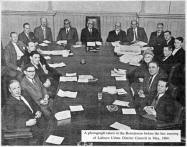 |
 |
| Lisburn Urban district council |
Lisburn Borough council |
MUCH TO
ECONOMY
Local banks have contributed much to the expansion of the economy
during the years.
The Northern Bank was established in Lisburn in 1835. Their first premises
were situated in Bow Street (it is said in the house ,afterwards occupied
by the Ulster Bank), later they moved to Castle Street and about the year
1870. the present building at the corner of Railway Street was erected and
occupied.
Manager of the first Ulster Bank opened in Market Square in 1865 was Mr,
John E. Morton. They moved to their Bow Street premises in 1871.
When looking at the town's industry no matter how briefly, the six modern
cabinet making firms cannot be overlooked. Since the beginning of the
present century they have grown in importance and now produce furniture of
quality and design second to none in the British Isles.
Lisburn is also the headquarters of the Army in Northern Ireland and is
proud of this long association, and of the many brave men from within the
boundary who have served, and died in two World Wars.
The headquarters of the Northern Ireland Fire Authority are situated in
Castle Street and the entire fire services of Northern Ireland, outside
the County Borough of Belfast, are managed and controlled from this
centre.
Operatic reputation
The Lisburn Choral and Orchestral Society of pre-war days gained a
high reputation for its operatic productions, it's last show, "The Earl and
The Girl," being performed in 1938.
Immediately after the war the Lisnagarvey Mate Voice Choir was formed.
Later a mixed-voice choir replaced the Male voice choir until finally in
1957 the present Lisnagarvey Operatic Society came into being.
The Society is fortunate in having as its President Lt.-Col, J. G.
Johnston, M.C, M.D., J.P., whom many people will remember playing
principal roles to the pre-war Society
The Musical Director is Mr. H. McM. Taggart, who is well-known in musical
circles and for each production he recruits local musicians for his
orchestra.
During the coming season the Society is breaking new ground by staging two
shows. "A Country Girl." in November, 1964, and a Gilbert and Sullivan
opera in April, 1965.

|
|
THE HISTORY of Lisburn as a town really begins in 1600, In that dramatic
year scores of Irish chieftains were in armsagainst the rule of the
English in Ireland, and among them was the chief of Killultagh whose
stronghold-the tiny village of Lisnagarvoch - formed the nucleus of the
modern town of Lisburn,
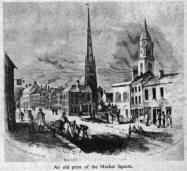 |
| An old print of the Market Square |
|
When this last rising of Gaelic Ireland failed, the territory of
Killultagh passed into the hands of Sir Fulke Conway, who invited English
and Welsh tenants to settle in his village of Lisnagarvey. When the Conway
Castle was built in 1627, fifty three tenements constituted the
settlement. In 1641, Bridge Street, Castle Street and the Market Square
area, the basic street formation of modern Lisburn, were already in
existence.
Of the great rebellion in 1641, in which Lisburn remained loyal to England
and King Charles 1, the records have this to say: "More than 300 of the
insurgents were slain in Bridge Street and 300 in Castle Street and in the
meadows behind the houses," The rebels, unable to take the town, reduced
it to ashes, whereupon the name of Lisnagarvey began to change to that of
Lisburn.
This survey was specialty written by Mr. Samuel McBratney, a Lisburn
student at Trinity College, Dublin.
A member of the College Historical Society, he had access to much
background material dealing with Lisburn's early beginnings, and his
article gives present day inhabitants an insight into the town's genesis
and evolvement. |
|
In 1707, another great fire halted the growth of Lisburn. Once again it
was reduced to ashes, this time even the great castle falling to the
flames. The castle was never rebuilt, but its gardens remained to become
the property of the people of Lisburn in the later nineteenth century,
In 1834, a writer with a lively imagination described these gardens as
"the bower of love and courtship for the lads and lovely lasses of
Lisburn. Beneath the outstretched branches of those trees, in the solemn
silence of evening, often have the vows of lovers been offered up on the
altar of affection." Time, it seems, cannot change the function of the
Castle Gardens.
Everyone knows the great gun there which was presented to the town in
1858. From this relic of Sebastopol. one may gaze down the Lagan Valley a
view still beautiful despite the marks of urbanisation and see the area
which the chief of Killultagh was concerned to defend in the time of
Elizabeth 1, when woods grew where the houses now are, and the salmon swam
plentiful in the Lagan,
This river, if a little trouble were taken to remove the squalor from its
banks, would greatly enrich the ,natural beauty of Lisburn to-day,

Classy Castle Street
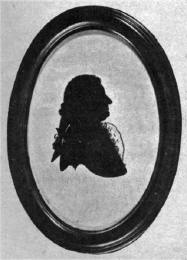 |
|
Louis Crommelin who died on July 17, 1727 |
|
After the great fire the key period of reconstruction in Lisburn was the
last quarter of the eighteenth century, Many houses were built, some of
them reaching four stories high. One gets the impression that Castle
Street was the higher class area of the town, and anyone who felt he had
any claim to superiority over his fellow citizens tried to get a house
there. The town's four magistrates and most of the wealthy linen
manufacturers lived in Castle Street, alongside the residence of the
Marquis of Hereford, to whom the territory had by this time reverted.
In 1800, Lisburn consisted of about 800 houses and 4,800 people. 1t was
almost a quarter of the size of Belfast which today is about twenty five
times that of Lisburn.
At this same period, the lower tract of the Lagan Valley was is the throes
of the industrial revolution and the spectacular economic development of
Lisburn was under way.
Strangely enough the Lisburn textile industries are indebted in no small
measure to Louis XIV of France, for in 1685 that monarch began a campaign
of persecution against the French Protestants, or Huguenots. These
refugees who fled from France enriched many parts of Europe, but perhaps
none as much as the Lagan Valley. Till well into the nineteenth century
men such as the Crommelins and the Delacherois helped to manufacture linen
which was equalled in few places, and bettered nowhere, in the world,
The era of large scale production began in 1764. In that year William
Coulson established his first linen looms close by what is now the Union
Bridge. In 1784, Barbour began spinning linen thread, and in 1831, the
works by this time moved to Hilden, employed over one and a half thousand
workers. Hilden, indeed, may be regarded as a by-product of the Barbour
thread spinning industry.
The next important year after Barbour's mill began was in 1789. Most
people know that the great French Revolution took
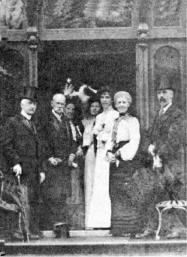 |
ON September 10, 1903,
Field-Marshal Earl Roberts, Commander-in-Chief of the British
Army, paid a visit to Lisburn for the express purpose of seeing
the birthplace of Brigadier-General Nicholson.
Pictured are (left to right), Mr. James A. Hanna, chairman of
Lisburn Urban District Council, Lord Roberts, Mrs. T Stannus,
Mrs. Harold Barbour, Mrs. Cowper, Mrs. George H. Clarke and Mr.
Clarke. The photograph was taken outside Mr. Clarke's residence,
"Roseville." |
place then, but are unaware of the revolution which began in
Lisburn in the same year. A Mr. Wallace returned from Glasgow with the
first steam engine to be seen in Ireland, and installed it in his cotton
mill just off Castle Street. Not only did the machine promise to
revolutionise industry, but it caused a sensation among the goggling
natives of the town.

World Famous Factories
Damask from Lisburn found it's way into most of the courts of Europe, and
such celebrities as the Archduke Michael of Russia, the Crown Prince of
Sweden, the Duke of Wellington and Lord John Russell, visited the world
famous Coulson factory.
An early nineteenth century bard of industry puts it this way:
"Where Coulson's damask, Barbours
thread
With Stewart's and the Island Spinning,
In workmanship the world have led,
High honours from the nations winning." |
This economic expansion had important consequences for Lisburn.
It led in 1765 to the opening of the Lagan for navigation from Lisburn to
Belfast, and to the establishment of a coach service to places such as
Dublin in the last decade of the nineteenth century. In 1839 the railroad
linked Lisburn with Belfast, and 3,000 people made the twenty minute
journey into Belfast by rail.
The expansion made some of Lisburn's citizens wealthy and made even
more of them poor. The Industrial Revolution. inaugurated a period of
intense hardship for the European working classes, and the Lagan Valley
did not escape this harsh price for steam power.
In 1762, over 300 weavers paraded through Lisburn brandishing blackthorn
sticks as a protest against the threat of unemployment, though it is worth
noting in this respect that the better-off citizens of Lisburn have a long
tradition of philanthropy. The Barbours provided 350 houses for their
employees, and the outbreak of cholera in 1830 was followed by the
building of a fever hospital on the Dublin Road by private subscription.
By such means the worst effects of nineteenth century capitalism were
softened in Lisburn.
A town, once established, thrives upon the necessities of its inhabitants.
Nowhere is this more clearly seen than in the case of religion, for in
satisfying their religious needs the people of Lisburn formed into social
units and built many impressive buildings. The first of these began in
1623 when the foundation stone of the Church of Ireland cathedral was laid
in Market Square, It is indicative of the part which religion has played
in the lives of Lisburn people, that the town's oldest institution is
religious in origin.
By 1834, each of the important Christian sects had a substantial following
among a population which numbered just over 6,000. The Quakers flourished
in Lisburn after the conversion to that faith of William Edmundson in
1676, and worshipped in Railway Street, as they still do today. In 1756
the founder of Methodism, John Wesley, visited the town and left behind
him an energetic band of Methodists who worshipped in Market Street. The
Roman Catholic community founded their place of worship in 1794 upon
Chapel Hill, and the Presbyterians, who had worshipped somewhere in the
Longstone area before the great fire of 1707, in 1834 had a congregation
of 500 families.

Greatest Need of Man
Up till at least the eighteenth century, religion could well be described
as the greatest need of man in society. As the nineteenth century dawned,
however, another great social need, that of education, challenged its
supremacy.
The first educational establishment of any importance in Lisburn - that
founded for the Quaker children in 1774 - was semireligious in character
and paid particular attention to the business of developing the moral
character of the child Not until 1880 the same year in which Sir Richard
Wallace founded the other Lisburn grammar school on the Antrim Road-did
the Friends' School open its gates to non-Quakers.
The first Lisburn school which did not ask it,s pupils whether they
attended church, chapel or meeting was that founded on the Dublin Road by
John Crossley in 1810, known then as the Male Free School. After this, no
decade of the nineteenth century passed without the foundation, of some
educational institution. In the forties, for example, were founded the
Longstone Infant School and Boulton's School - now a primary school on the
Hillhall road.
For all this interest in education, however, it is no injustice to the
people of Lisburn to say that they have largely wanted probing intellects.
A well known authoress of the earlier nineteenth century described Lisburn
people as "destitute of literary taste," and it is true that apart from a
rather abortive literary-cum-debating society which existed in the middle
of the century, there was little interest in the arts.
As for politics, after the hanging of townsman Henry Munro for his part in
the 1798 rebellion, the town steered clear of political agitation until
the Home Rule controversy.
Jeremy Taylor, one of the most agile minds of the seventeenth century,
lived in Lisburn for some time, and eventually died there in 1667, "Let us
hope," writes an early twentieth century commentator," that some attention
will be directed towards the preservation of all that renders the Bishop's
(i.e., Taylor's) study at Magheraleave one of the most interesting of
local antiquities, for it is indeed an honour to our town that its streets
were once trodden by the author of The Liberty of Prophesying.' "
It is noteworthy that when Lisburn built her statue in Market Square, she
chose to immortalise John Nicholson, soldier, rather than Jeremy Taylor,
scholar.

Distribution of trade |
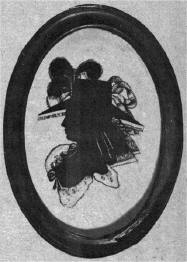 |
|
Anne Crommelin,
died august 15, 1755 |
|
As a final item In this survey of Lisburn's growth
it might be informative to examine the distribution of shops and trades in
a particular year. In the year 1819-the year for which most facts are available-the most
popular occupation was that of shoemaker. There were no less than
forty-four, Next came the twenty-eight publicans, who outnumbered the
grocers by four. As well as intoxicating beverages the town was well
provided with meat, especially the Smithfield area, which had nineteen
butchers. There were sixteen carpenters, five schoolmasters, two surgeons,
two physicians, four pawnbrokers (each of them strategically placed near
Market Square). and about eleven bakers. The busiest streets in 1819, one feels, must have been Bow Street and
Bridge Street, for while the former boasted eleven of the town's public
houses (note that Bow Street is well removed from the higher class, Castle
Street in 1819), the latter had twelve of the town's twenty-four grocers. In comparison with the present day, it seems that trade has largely swung
away from Bridge Street to Bow Street (and now, perhaps, into Smithfield
centre) for Bridge Street no longer contains half of the town's grocers. Bow Street is nowadays a thriving shopping area, whereas in 1819, it
contained chiefly tradesmen such as carpenters and shoemakers.
The most obvious comparison is that Lisburn in 1964 is thriving as
Lisburn throve in 1819, and is, it may be added substantially more sober.
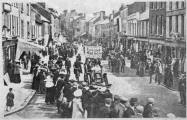 |
| There was a big turnout in
Bow street to see one of the first cars to visit the town |
|
This survey does not go beyond the seventies of the nineteenth century. By
that period, the people of Lisburn had achieved economic and social
maturity and had made their town indispensable to the economic activity of
the Lagan Valley. By and large, it may be said of the people who created Lisburn, that they
led thrifty, hard-working lives, somewhat addicted to the fluctuations of
profit and loss and having little inclination towards intellectual
pursuits. Living in the age of inventions, their unspectacular, but far from mundane
lives, were jolted from time to time by such sights as the early steam
engines or the first locomotive. After the formation of the Lisburn cricket club in 1836, they developed a
passion for the game equal to that of their English contemporaries.
For a long time they had no dance hall, and it is amusing to come across a
question put in 1834, "Will those beautiful forms-- the soul of
symmetry-and the neat foot and ankle, ever appear again in the mazy dance,
when the daughters of Lisburn resembled so many sylvan goddesses,
'tripping it along on light fantastic toe.' " It may not be an infallible test of progress, but if the writer were alive
today he could see the daughters of Lisburn go down to the mazy dance in the
town's newest institution the ballroom.
 |